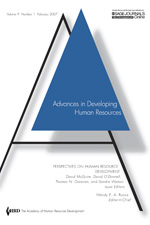Top Five: Advances in Developing Human Resources
 This week, we present the top five most-read articles currently available from Advances in Developing Human Resources. Covering a range of topics, from leadership development to the multigenerational workforce, they offer findings including:
This week, we present the top five most-read articles currently available from Advances in Developing Human Resources. Covering a range of topics, from leadership development to the multigenerational workforce, they offer findings including:
- How managers can increase levels of employee engagement as a strategic leverage point within organizations
- Suggestions for individual leaders to navigate their personal leadership development journey
- Ways that HRD professionals can increase retention of valued workers across generations
These articles—some new, some classic—are freely available to access using the links below through April 6. Please share and enjoy!
Jerry W. Gilley, M. Lane Morris, Alina M. Waite, Tabitha Coates, and Abigail Veliquette
Integrated Theoretical Model for Building Effective Teams
February 2010
Sehoon Kim and Gary N. McLean
Global Talent Management: Necessity, Challenges, and the Roles of HRD
November 2012
Barbara A. W. Eversole, Donald L. Venneberg, and Cindy L. Crowder
Creating a Flexible Organizational Culture to Attract and Retain Talented Workers Across Generations
November 2012
Byron Hanson
The Leadership Development Interface: Aligning Leaders and Organizations Toward More Effective Leadership Learning
February 2013
Paul Fairlie
Meaningful Work, Employee Engagement, and Other Key Employee Outcomes: Implications for Human Resource Development
November 2011
Click here to receive e-alerts and stay up-to-date with the latest articles from Advances in Developing Human Resources.






























































































